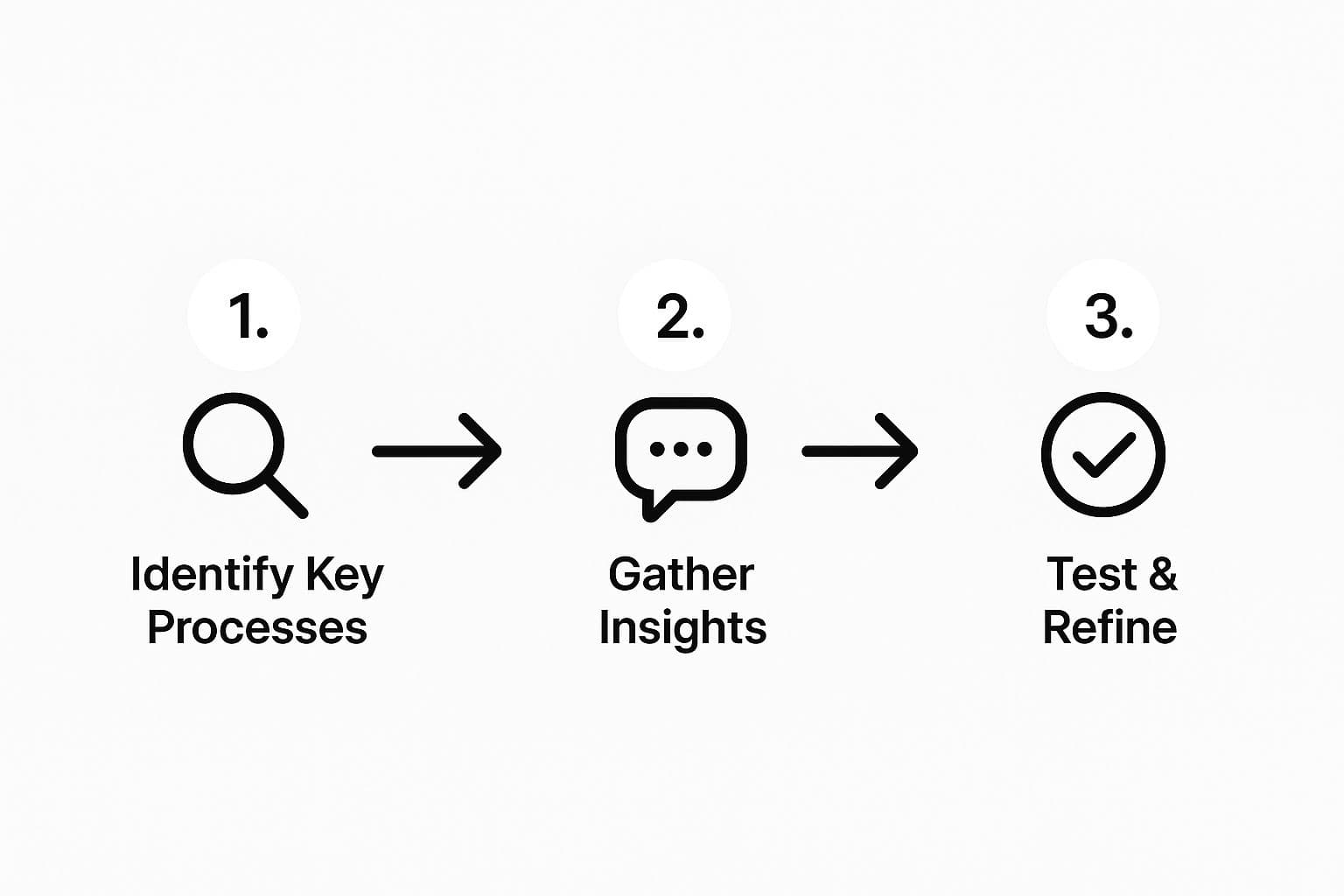Process documentation is simply the act of writing down how you do things. Think of it as creating a detailed recipe for every important task in your business, making sure anyone can step in and get it done right, every single time. It's about turning that hard-earned knowledge floating around in your employees' heads into a concrete, reliable company asset.
Unpacking What Process Documentation Really Means

Imagine your business is a busy kitchen. If every chef just "wings it," you’ll get wildly different results day after day. Process documentation is your official cookbook. It spells out the exact ingredients, steps, and timing needed to deliver a perfect outcome consistently.
This goes way beyond just jotting down a few notes. It’s a deliberate effort to create a single source of truth for your workflows. It takes that "tribal knowledge"—the crucial information only a few key people know—and makes it available to everyone.
The Core Purpose of Documentation
At its heart, the goal is to get rid of guesswork and confusion. When your processes are clearly laid out, your team can move forward with confidence and speed. This documentation serves a few critical functions:
- Training New Hires: It gives new team members a clear roadmap, helping them get up to speed much faster and with less hand-holding.
- Ensuring Consistency: It makes sure tasks are done the same way, every time. This is absolutely vital for maintaining quality and keeping customers happy.
- Improving Processes: Once you map out a workflow, you can immediately see the weak spots—the bottlenecks, the wasted steps, and the opportunities for improvement.
- Preserving Knowledge: It acts as an insurance policy, protecting your company from losing critical know-how when an experienced employee moves on.
From Playbook to Strategic Asset
To give you a clearer picture, here’s a quick breakdown of what goes into effective process documentation.
Process Documentation at a Glance
| Component | Description | Example |
|---|---|---|
| Process Title | A clear, simple name for the workflow. | "Onboarding a New Client" |
| Purpose | A brief statement on why this process exists. | "To ensure a smooth and consistent setup for all new clients." |
| Scope | Defines the start and end points of the process. | "Begins when a contract is signed; ends when the client kickoff is complete." |
| Roles & Responsibilities | Who does what at each step. | "Account Manager sends welcome packet; Project Manager schedules kickoff." |
| Step-by-Step Guide | The detailed actions needed to complete the process. | "1. Create client folder in Drive. 2. Add client to Slack channel..." |
| Tools & Resources | Any software or documents required. | "Salesforce, Asana, Welcome Packet Template" |
Ultimately, great process documentation is more than a manual; it’s a cornerstone of solid knowledge management. By capturing and organizing how your business runs, you build a stronger, more resilient system that can grow and get better over time.
This isn't about micromanagement. It's about building a foundation of clear, repeatable systems that empower your whole team to do their best work.
Why Your Business Needs Clear Documentation
It's easy to dismiss process documentation as just another boring administrative task. That’s a huge mistake. Think of it less as paperwork and more as a strategic asset that makes your business stronger and ready for growth. It takes all that scattered, informal knowledge floating around and turns it into a reliable, shared playbook that protects your company from the inside out.
Let’s be real. What happens if the one person who knows your client billing process inside and out suddenly leaves? Without documentation, you're left with a massive knowledge gap. Chaos, errors, and a scramble to figure things out are pretty much guaranteed. This is exactly where clear documentation becomes your business's insurance policy.
Preserve Mission-Critical Knowledge
Every company has "tribal knowledge"—those unwritten rules and shortcuts that only seasoned employees know. While it's great to have experienced people, relying solely on what's in their heads is incredibly risky. Process documentation is how you capture that expertise and make it a permanent, accessible part of your company.
This means critical workflows don't grind to a halt just because someone is on vacation, out sick, or finds a new job. It’s all about protecting your operational continuity and safeguarding the institutional memory you've worked so hard to build.
Drive Consistency and Quality Control
When there isn't a documented standard, the same task often gets done five different ways by five different people. The result? Inconsistent outcomes for your customers and headaches for your internal teams. A documented process is the official playbook, making sure everyone is on the same page and following the same proven steps.
This consistency is the foundation of quality control. It ensures that whether you're onboarding a new client or handling a support ticket, the experience is predictable and up to your standards—every single time. Once you’ve defined the "right way" to do things, it also becomes much easier to streamline business processes for growth and spot opportunities to get even better.
Accelerate Onboarding and Training
Think about how long it takes a new hire to get up to speed. With clear process documentation, you can slash that time significantly. Instead of constantly tapping their colleagues on the shoulder for help, new employees have a go-to resource to learn how things are done.
This not only frees up your senior team's time but also empowers new hires to start contributing in a meaningful way, much faster. The demand for this kind of clarity is huge. In Australia alone, the document preparation services industry is valued at roughly $307.5 million for 2025, which just goes to show how essential this is for businesses of all sizes. Well-structured documentation quickly becomes the backbone of any effective and scalable training program.
Building a Truly Useful Process Document

Let's be honest: most process documents are just glorified checklists. They get the job done, but they don't inspire confidence. A great process document is something else entirely. It’s a communication tool designed to kill confusion before it even starts.
The real goal is to create documentation that people actually want to use. It should be a self-contained guide, something anyone on the team can pick up and use to complete a task perfectly, without having to tap someone on the shoulder for help.
Before you even think about writing down steps, you need to nail down the purpose. Why does this process exist? Answering that question gives your team the "why" behind the "what," which is the secret to getting everyone on board and ensuring things are done right every time.
The Anatomy of an Effective Document
To get there, every document needs a solid skeleton. Think of these as the non-negotiable parts that make a guide clear, complete, and easy to follow. If you skip any of them, you’re just creating gaps for mistakes to creep in.
Here are the core components every process doc should have:
- A Clear Purpose: Start with a simple, direct statement. For example, "To ensure all customer refunds are processed accurately and within 24 hours."
- Defined Scope: Clearly state where the process starts and stops. This prevents people from missing steps or doing someone else's work.
- Roles and Responsibilities: Spell out who does what. A RACI (Responsible, Accountable, Consulted, Informed) chart is perfect for this, as it eliminates any guesswork about ownership.
- Step-by-Step Instructions: This is the heart of your document. Write out each action in order. Use simple, direct language and ditch the jargon.
Bringing a Process to Life with an Example
Let’s see how this works with a real-world task: Processing a Customer Refund. A lazy document might just say, "Give the customer their money back." A useful one, however, leaves absolutely no room for interpretation.
Imagine you're a new hire in customer service. The document you get should feel like a complete roadmap, guiding you through every single click and decision. That level of detail is what turns a simple to-do list into a system that guarantees quality.
Here’s what a properly structured guide for this would look like:
- Verify the Refund Request: First, check the customer's purchase history in the billing system to confirm the original transaction details.
- Process in Payment Gateway: Next, log into the payment processor, find the transaction, and issue the refund for the correct amount.
- Update the CRM: Go to the customer's profile in the CRM and add a note explaining the refund reason and amount.
- Notify the Customer: Finally, use the pre-written "Refund Confirmation" email template to let the customer know their refund is on its way.
When you structure it like this, it doesn't matter who handles the refund—the result is always the same. That's what good process documentation is all about.
Your Step-by-Step Guide to Creating Documentation
Turning messy, undefined workflows into clear, repeatable instructions doesn't just happen. It takes a deliberate plan. Think of creating process documentation as translating the "way we do things" into a guide that anyone can pick up and follow. Let's break down how to tackle this in a few manageable stages.
The first step is always the hardest: deciding where to start. You can’t document everything at once, so you have to be smart about it. Focus on the high-impact stuff first—that's where you'll see the biggest and fastest payoff for your effort.
This infographic gives you a bird's-eye view of the entire workflow.

As you can see, it's a journey. You start by identifying a need, then you go straight to the source to gather information, and finally, you polish it up through real-world testing.
Step 1: Identify and Prioritize Key Processes
Before you type a single word, figure out what you're trying to achieve. Is the goal to speed things up? Cut down on mistakes? Make training new hires easier? Knowing your "why" helps you pinpoint which processes to tackle first.
Start by listing out the workflows that are absolutely essential, done all the time, or just plain confusing for everyone. A great place to begin is with core business functions—anything that directly touches your revenue or keeps customers happy.
Once you have that list, it's time to prioritize. Ask yourself a few simple questions:
- What breaks if this is done wrong? Things involving compliance, safety, or money usually shoot to the top of the list.
- What does a new hire absolutely need to know? Documenting these can slash ramp-up time by a whopping 30-50%.
- Where are the bottlenecks? What do people ask about over and over again? Fixing these pain points gives your team an immediate win.
Step 2: Gather Insights from the Experts
The best information won't come from a manager’s office; it comes from the people actually doing the work day in and day out. Documentation written in a vacuum is doomed to be inaccurate and ignored. So, go talk to your team's subject matter experts.
Block off some time to watch them in action. Ask questions. You need to understand not just what they do, but why they do it that way. This is your chance to uncover all the little tricks and unwritten rules that really make a process work.
Step 3: Draft, Test, and Refine
Okay, now you can start writing. Use simple, clear language and steer clear of company jargon. Break things down with headings, bullet points, and numbered lists to make the document easy to scan and digest.
But the most important part of this whole step is testing. Hand your draft to someone who has never done the process before. Ask them to follow your instructions—and don't give them any hints. Their struggles and successes are the ultimate proof of how clear your document really is.
Take their feedback, make your changes, and refine the document. This cycle of drafting, testing, and tweaking is what turns a decent document into a great one. And once it's done, set a reminder to review it every so often. Processes change, and your documentation needs to keep up.
Keeping Your Documentation Alive and Relevant
Getting your process documentation written is a huge win, but the work doesn’t stop there. Honestly, the biggest mistake most companies make is creating these fantastic guides and then letting them gather digital dust.
Outdated documentation is actually worse than having none at all. It breaks trust, creates confusion, and can lead people to make some pretty serious errors. Think of your documentation less like a static manual and more like a living library of knowledge that grows and changes with your business.
Without a solid plan to keep things fresh, even the most perfect guide will become useless. A process gets an upgrade, a new software tool is rolled out, or someone on the team finds a smarter way to get something done. If the documentation doesn't reflect that reality, people will just stop using it. Simple as that.
Establish Clear Ownership and Review Cycles
First things first: every document needs an owner. This is non-negotiable. Someone has to be directly responsible for keeping each process guide accurate. This doesn't have to be a manager; in fact, the best owner is usually the person who lives and breathes that process every day.
With an owner in place, you need a regular review schedule. This simple step prevents guides from being forgotten until a problem pops up. A good rule of thumb is to check in on critical or fast-changing processes every quarter, while the more stable ones can be reviewed once a year.
Here’s a simple schedule to get you started:
- Quarterly Reviews: Perfect for high-impact processes like client onboarding, billing procedures, or core product workflows.
- Annual Reviews: Great for stable, "set-it-and-forget-it" processes like HR policies or annual compliance checks.
- Immediate Updates: This one's a biggie. The moment a tool, step, or policy changes, the documentation needs to be updated right away.
Use Feedback and Data to Drive Updates
Your team on the front lines is your greatest asset for keeping docs current. Make it easy for them to flag anything that's confusing, wrong, or could be done better. This creates a natural feedback loop that fuels continuous improvement.
You can also use data to spot where a process is going off the rails. For example, tools that offer Workflow History Timelines have been a game-changer for process tracking. They give you a complete, chronological view of every action, status change, and comment related to a task. This makes it so much easier to see where the documented steps don't match what’s actually happening. You can discover more insights about how teams are using workflow timelines on ones.com.
By combining hands-on feedback from your team with hard data from your workflows, you can stay ahead of the curve. This approach ensures your what is process documentation efforts pay off in the long run, turning static files into dynamic assets that truly help your team do their best work.
Choosing the Right Tools for the Job

Picking a tool for your process documentation is a bit like choosing between a hammer and a power drill. Sure, both can get the job done, but your choice really depends on the task at hand. The right tool can make documentation a breeze, while the wrong one can become a source of constant frustration for your team.
Don't get dazzled by a long list of features. The best decision is based on what fits your team's current habits and the complexity of the processes you need to map out. A simple checklist in a shared document might be all you need for a straightforward task. But for a workflow that spans multiple departments, you'll almost certainly need something more powerful, probably with visual tools like flowcharts.
The real goal is to find a system that makes creating, finding, and updating information as easy as possible. If a tool is a pain to use, your team will find workarounds, and all your hard work on documentation will go to waste.
Finding Your Perfect Fit
The market is full of options, from the word processor you use every day to highly specialized process management platforms. Each has its strengths and is built for different kinds of teams and challenges.
Let’s break down some common choices to help you figure out what you need:
- Shared Documents (Google Docs, Microsoft Word): Perfect for small teams and simple processes. Most people already know how to use them, so there’s virtually no learning curve. They're a great starting point.

